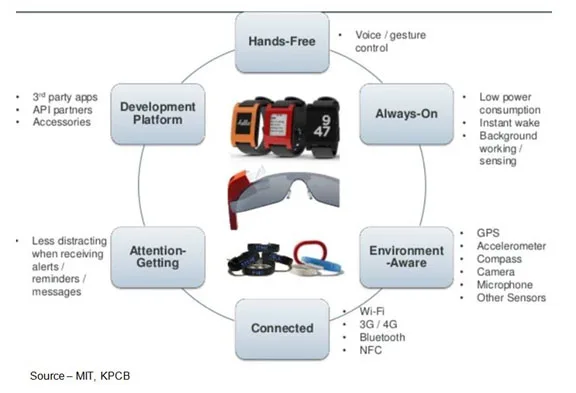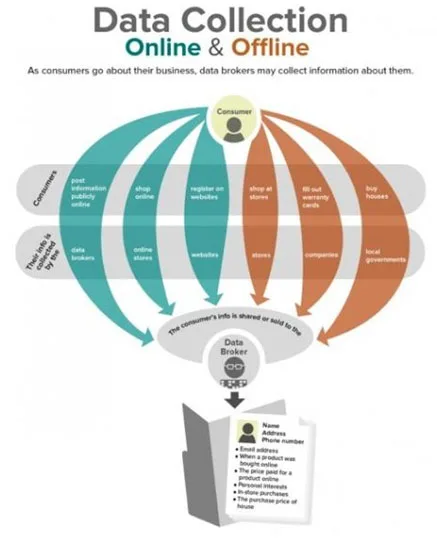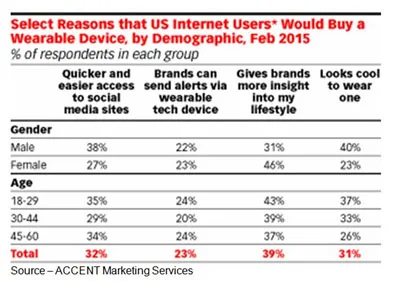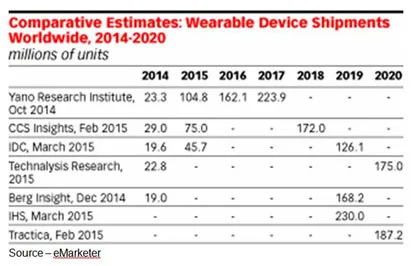Always Capturing Personal Info, Wearables Are Giant Siphons

I’ve been thinking about getting a fitness or activity wearable to help me “shave” a few percentage points off my BMI (body mass index).
My doctor said it wasn’t bad since I’m a vegetarian, exercise five days a week and don’t drink alcohol. ”Besides,” he added, “it’s only a number.”
Yeah sure, but that number made my six-pack disappear; so I have a few choices:
- Grow a couple of inches
- Exercise more
- Eat better
- Find a BMI formula that agrees with me
Obviously, the answer is to do what my kids did – add some wearables to go with my Apple Watch. There certainly are enough to choose from.
Add a couple of fitness and activity bands along with smart socks, t-shirt and associated accessories; and in no time at all, I’ll be in touch with everything I do.
The devices store a little information for you and me.
They send it to your iPhone/smartphone where a free app that keeps track of the daily and cumulative information lets you track your progress. Or, better yet, lets you post it to a site where you can compare your activity and progress with friends and associates you have a friendly bet with.
If your boss thinks you work better when you’re healthy he/she may have worked out a special program with the insurance company to offer “good health” discounts if you do everything just right so you save a nice chunk of money every month.
Helluva’ deal!
 Everything, Everywhere – KPCB’s Mary Meeker (along with almost every industry analyst out there) sees wearable technology being used everywhere for business, personal fitness, health maintenance and infotainment. The potential is huge. So are the issues that need to be overcome.
Everything, Everywhere – KPCB’s Mary Meeker (along with almost every industry analyst out there) sees wearable technology being used everywhere for business, personal fitness, health maintenance and infotainment. The potential is huge. So are the issues that need to be overcome.
What could be the harm?
It turns out your devices are helping you create gobs of information about you. In other words, you’re just a fountain (really a fire hydrant) of information.
All of those wearables contribute to a growing pile of information about you that’s captured by your smartphone, tablet, social media posts and stored … somewhere by someone.
What kind of information? Glad you asked. Of course it depends on your wearable as well as the other devices, apps, sites/clouds you use and how many EULAs (end user licensing agreements) you checked off.
There’s no need to read the mouse type because you’re just too excited to take advantage of all the coolness and besides, except for Apple, it probably goes to one or more of the folks who make a great living collecting all that stuff – data brokers.

More Data – The more technology individuals use, companies and data brokers will be enriching their package of information about people to help organizations market to and serve people better. Some will use it only for their activities but many will sell, resell, reuse the information to product and service providers.
They do a brisk business scrounging everywhere – online, offline, dumpster diving (O.K., I lied about that … I think). With everyone using these devices and cloud collectors, they racked up about $450M in sales last year.
You know, stuff according to the FTC (Federal Trade Commission):
- Identifying data: name, address, etc.
- Sensitive identifying data: Social Security number, driver’s license number, etc.
- Demographic data: age, gender, race, languages spoken, employment, religion, etc.
- Court and public record data: bankruptcies, criminal convictions, marriage licenses, voting registration, etc.
- Social media and technology data: purchases, level of usage, Facebook and Twitter usage, number of friends in social networks, online influence, etc.
- Home and neighborhood data: dwelling type, home loan, interest rate, etc.
- General interest data: apparel preferences, attendance at sporting events, gambling, magazine subscriptions, media channels used, pets, preferred movie and music genres, etc.
- Financial data: ability to afford products, credit card user, credit worthiness, financially challenged, discretionary income level, net worth, tax return transcripts, etc.
- Vehicle data: brand preferences, propensity to purchase new or used vehicle, motorcycle owner, intent to purchase vehicle, etc.
- Travel data: highest price paid for travel purchase, cruises booked, preferred vacation destination, date of last travel purchase, etc.
- Purchase behavior data: amount spent on goods, buying activity, method of payment, buying channel preference (internet, mail, phone), shooting game purchases, guns and ammunition purchases, purchase of plus-sized clothing, average days between orders, novelty Elvis purchases, etc.
- Health data: tobacco usage, allergies, prescription purchases, brand name medicine preference, contact lenses user, weight loss supplements, reported interest in various health topics, etc.
But it’s O.K. because it’s all used to better serve you … except when it’s not!
Of course, you didn’t read all those EULAs when you said “gimme the access.” And even if you did, you couldn’t understand them. Not even the lawyers who wrote them understand them.
Basically, what they say though is “Thank you, you’re …”
 But let’s face it, consumers (you and I) have very little self-control.
But let’s face it, consumers (you and I) have very little self-control.
We demand privacy but we love convenience.
So folks don’t really think too much about the data that is collected and how it is/can be possibly used.
When you’re staring at one of those new devices or your eyes lust after a bunch of those free apps, you can use to show off how cool you are with your wearable(s).
 You Know You Will – If you don’t already have your Apple Watch, or other smartwatch, as well as a fitness/wellness band or two along with a bunch of free or super cheap apps to capture all of your neat info so you can show it off to friends and relatives, you will. After all, it’s like so cool.
You Know You Will – If you don’t already have your Apple Watch, or other smartwatch, as well as a fitness/wellness band or two along with a bunch of free or super cheap apps to capture all of your neat info so you can show it off to friends and relatives, you will. After all, it’s like so cool.
Come on, who doesn’t want to get a message on their smartwatch and wearable that says “OMG, get in here right now! We have a wicked sale going on.”
Of course, the messenger needs to know where you’re at, what you’re doing. Better yet – and far more effective – it buzzes you when you’re walking by the store or coffee shop or restaurant. Given enough data, it will soon be able to figure out you’re thinking about them and BAM! you have mail.
It’ll be possible because industry analysts forecast that by 2025, sensors/devices will be generating more data than is produced from everything today.
As Basil Hashem, VMware’s senior director of end user computing, reminded us, “In our lives, conveniences seem to trump privacy every time.”
Josh Lifton, head of Crowd Supply, added, “If you want to be considered an individual and not just a data point, then it’s in your interest to protect your privacy.”
That’s easier said than done because all of that stuff goes up into little individual clouds which are really part of a few really big clouds.
And everyone says people are going to buy millions. Millions they say … millions for the office and the home.
 From Modest to Bullish – It was only a couple of years ago that people wondered what in the heck you needed a wearable whatever unless you were serious about your workout schedule. But now, people are buying them for getting back into shape or at least showing folks how serious they are about being the fit person in the room. If it helps even a little … great.
From Modest to Bullish – It was only a couple of years ago that people wondered what in the heck you needed a wearable whatever unless you were serious about your workout schedule. But now, people are buying them for getting back into shape or at least showing folks how serious they are about being the fit person in the room. If it helps even a little … great.
That means your company’s IT department is supposed to provide security, despite your dumb passwords and careless use of your device.
They’re “a little” scared about all of the company data you carry around everywhere with you already with your notebook, tablet, iPhone and their apps.
Add your wearables and things just got worse for them … lots worse.
Sure, the company secrets might be valuable to someone but your personal stuff is valuable to anyone on the dark web. In fact, Gary Davis, Intel Security’s chief consumer evangelist, said its worth 10x more than your maxed out credit cards.
And then the wearable cloud (or an associated cloud somewhere) also has innocuous stuff like your Social Security number, date of birth, where you live/what you do/when you do it. Oh crap, everything!
The problem is most of the manufacturers are in a rush to get their newer, better, sexier bling out there as quickly as possible.
Being the most secure wearable available period is not high on the consumer’s gotta’ have list when he/she is buying a new wearable.
Tell the folks who are checking out your new wearable about all the designed-in security and how much more it cost than theirs and they’ll probably sing a song’s lyrics to you, “That don’t impress me much.”
Ultimately, governments and the industry will have to address the privacy/security issues; and we both know how long that takes.
Until then, you can just have your wearable(s) talk to your smartphone only and not share all of that important stuff with anyone, including your doctor or Starbucks.
 Too many folks right now are in the same position as Cher when she said, “I felt impotent and out of control. Which I really, really hate. I had to find sanctuary in a place where I could gather my thoughts and regain my strength…”
Too many folks right now are in the same position as Cher when she said, “I felt impotent and out of control. Which I really, really hate. I had to find sanctuary in a place where I could gather my thoughts and regain my strength…”
# # #